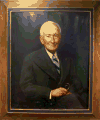Endoscopic third ventriculostomy: A historical review
- PMID: 27774823
- PMCID: PMC5922250
- DOI: 10.1080/02688697.2016.1245848
Endoscopic third ventriculostomy: A historical review
Abstract
Background: Endoscopic third ventriculostomy (ETV) has become one of the most common neuroendoscopic procedures.
Methods: In this article, we will review the major milestones in the history of ETV development from its early use by Walter Dandy to the techniques currently employed with advanced technology.
Conclusions: ETV has become an important technique in the armamentarium of the neurosurgeon. From a meager beginning with few applications, our knowledge of long-term outcomes has evolved. ETV has a rich history and more recently, has had a renewed interest in its use. Our current understanding of its indications is growing and is based on a century of development through trial and error.
Keywords: Ventriculostomy; history; hydrocephalus; neuroendoscopy; neurosurgery.
Figures








References
-
- Boockvar JA, Loudon W, Sutton LN. Development of the Spitz-Holter valve in Philadelphia. J Neurosurg. 2001;95(1):145–147. - PubMed
-
- Chrastina J, Novak Z, Riha I. Neuroendoscopy. Bratisl Lek Listy. 2008;109(5):198–201. - PubMed
-
- Dandy WE. An operative procedure for hydrocephalus. Bull Johns Hopkins Hosp. 1922;33:189–190.
-
- Dandy WE. Cerebral ventriculoscopy. Bull Johns Hopkins Hosp. 1922;33:189.
-
- Decq P, Schroeder HW, Fritsch M, Cappabianca P. A history of ventricular neuroendoscopy. World Neurosurg. 2013;79(2):S14–e1. - PubMed
Publication types
MeSH terms
Grants and funding
LinkOut - more resources
Full Text Sources
Other Literature Sources
Medical
